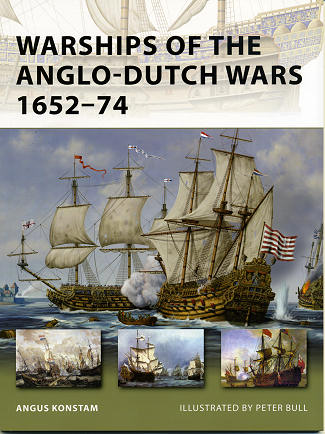 The next New
Vanguard title is on the warships of the Anglo-Dutch wars. This was a time of
much turmoil in Europe with the Dutch having defeated the Spanish and the
British undergoing the throes of the Republic, followed by the Restoration and
its excesses. (Editor's note: in actuality, I should use Commonwealth in place
of British, but British is easier to type and you know what I mean).
The next New
Vanguard title is on the warships of the Anglo-Dutch wars. This was a time of
much turmoil in Europe with the Dutch having defeated the Spanish and the
British undergoing the throes of the Republic, followed by the Restoration and
its excesses. (Editor's note: in actuality, I should use Commonwealth in place
of British, but British is easier to type and you know what I mean).
One thing that remained fairly constant is that the British
needed a sizeable fleet, but then so did the Dutch as this was at probably the
height of their expansion. Since both nations were concerned about dominance on
the high seas, it was inevitable that there would be strife. This resulted in a
succession of three wars, all of which were won by the Dutch.
These wars were pretty much wars at sea and fought by two
nations that were rather different in their make-up. While the Commonwealth of
England, Scotland and Ireland was somewhat unified under one rule, the Dutch
Republic were much looser in that each province had their own ship building
yards and they did not conform to a national standard as did the British. Both
the British and Dutch fleets were comparable in size, and general structure of
the ships, but that is where the similarity ended.
British ships were more strongly built and of a deeper draft
than Dutch ships. Dutch ships were limited by the shallow waters around their
nation and so their ships were lighter built and of shallower draft. However,
they were wider, which made them excellent gun platforms and also made the ships
faster and more maneuverable. The more strongly built British ships were able to
take more damage and able to carry larger guns. However, this was often
overshadowed by superior Dutch seamanship which prevented the British from using
their heavier weight of broadside.
During the first war, the way these battles were fought were
for each captain to act independently of the others, thus turning sea battles
into huge melees with ships everywhere. By the time of the second war, the
British had figured out that having all ships under one command and sailing in
line would provide more firepower on either side and protect the front and rear
of the ships. Getting British captains to do this, however, was not the easiest
to do and so the Dutch again won.
In the third war, the British had finally gotten the idea,
and while this made such an impression on the way sea battles were fought until
Nelson, the Dutch, despite having almost no new ships since the last war, still
used their superior tactics and luck to win the third war.
Author Angus Konstam does a superlative job of discussing
both the historical background of these wars as well as the ships involved, the
tactics used and the way crews were trained. Not surprisingly, getting crews in
time of war was difficult for both sides. The British impressed people into
service while the Dutch used a lot of Scandanavian hires. It is interesting to
read that the Dutch, instead of laying up ships in between the wars, used their
warships in the trade routes.
I also found it interesting that many of the drawings of
ships of both sides came from Dutch artists Willem van de Velde the Elder and
Younger. These period drawings are of just the hulls, minus the masts, sails and
rigging. This is enhanced by various paintings and the art work of Peter Bull.
Overall, an excellent reference and most interesting read in
a period of history that has escaped the notice of many of us. Highly
recommended.
December 2011
For more on the complete line of Osprey books,
visit www.ospreypublishing.com. In the US, it is
Osprey Direct at 44-02 23rd St, Suite 219, Long Island City, NY 11101., where you can
get a catalogue of available books.
If you would like your product reviewed fairly and quickly, please contact
me or see other details in the Note to
Contributors.
 The next New
Vanguard title is on the warships of the Anglo-Dutch wars. This was a time of
much turmoil in Europe with the Dutch having defeated the Spanish and the
British undergoing the throes of the Republic, followed by the Restoration and
its excesses. (Editor's note: in actuality, I should use Commonwealth in place
of British, but British is easier to type and you know what I mean).
The next New
Vanguard title is on the warships of the Anglo-Dutch wars. This was a time of
much turmoil in Europe with the Dutch having defeated the Spanish and the
British undergoing the throes of the Republic, followed by the Restoration and
its excesses. (Editor's note: in actuality, I should use Commonwealth in place
of British, but British is easier to type and you know what I mean).